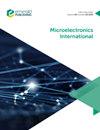Structural and mechanical properties of a-axis AlN thin films growth using reactive RF magnetron sputtering plasma
IF 0.8
4区 工程技术
Q4 ENGINEERING, ELECTRICAL & ELECTRONIC
引用次数: 0
Abstract
Purpose This paper aims to report the influence of sputtering plasma deposition time on the structural and mechanical properties of the a-axis oriented aluminium nitride (AlN) thin films. Design/methodology/approach The AlN films were prepared using RF magnetron sputtering plasma on a silicon substrate without any external heating with various deposition times. The films were characterized using X-ray diffraction (XRD), field-emission scanning electron microscope (FESEM), atomic force microscope (AFM) and nanoindentation techniques. Findings The XRD results show that the AlN thin films are highly oriented along the (100) AlN plane at various deposition times indicating the a-axis preferred orientation. All the AlN thin films exhibit hexagonal AlN with a wurtzite structure. The hardness and Young’s modulus of AlN thin films with various deposition times were measured using a nanoindenter. The measured hardness of the AlN films on Si was in the range of 14.1 to 14.7 GPa. The surface roughness and the grain size measured using the AFM revealed that both are dependent on the deposition times. Originality/value The novelty of this work lies with a comparison of hardness and Young’s modulus result obtained at different sputtering deposition temperature. This study also provides the relation of AlN thin films’ crystallinity with the hardness of the deposited films.反应性射频磁控溅射等离子体生长a轴AlN薄膜的结构和力学性能
目的研究溅射等离子体沉积时间对a轴取向氮化铝(AlN)薄膜结构和力学性能的影响。设计/方法/方法使用RF磁控溅射等离子体在硅衬底上制备AlN薄膜,无需任何外部加热,沉积时间不同。利用X射线衍射(XRD)、场发射扫描电子显微镜(FESEM)、原子力显微镜(AFM)和纳米压痕技术对薄膜进行了表征。XRD结果表明,在不同的沉积时间下,AlN薄膜沿(100)AlN平面高度取向,表明a轴取向是优选的。所有的AlN薄膜都呈现出纤锌矿结构的六方AlN。用纳米压头测量了不同沉积时间下AlN薄膜的硬度和杨氏模量。Si上的AlN膜的测量硬度在14.1至14.7的范围内 GPa。使用AFM测量的表面粗糙度和晶粒尺寸表明两者都取决于沉积时间。新颖性/价值这项工作的新颖性在于比较了在不同溅射沉积温度下获得的硬度和杨氏模量结果。本研究还提供了AlN薄膜的结晶度与沉积薄膜硬度的关系。
本文章由计算机程序翻译,如有差异,请以英文原文为准。
求助全文
约1分钟内获得全文
求助全文
来源期刊

Microelectronics International
工程技术-材料科学:综合
CiteScore
1.90
自引率
9.10%
发文量
28
审稿时长
>12 weeks
期刊介绍:
Microelectronics International provides an authoritative, international and independent forum for the critical evaluation and dissemination of research and development, applications, processes and current practices relating to advanced packaging, micro-circuit engineering, interconnection, semiconductor technology and systems engineering. It represents a current, comprehensive and practical information tool. The Editor, Dr John Atkinson, welcomes contributions to the journal including technical papers, research papers, case studies and review papers for publication. Please view the Author Guidelines for further details.
Microelectronics International comprises a multi-disciplinary study of the key technologies and related issues associated with the design, manufacture, assembly and various applications of miniaturized electronic devices and advanced packages. Among the broad range of topics covered are:
• Advanced packaging
• Ceramics
• Chip attachment
• Chip on board (COB)
• Chip scale packaging
• Flexible substrates
• MEMS
• Micro-circuit technology
• Microelectronic materials
• Multichip modules (MCMs)
• Organic/polymer electronics
• Printed electronics
• Semiconductor technology
• Solid state sensors
• Thermal management
• Thick/thin film technology
• Wafer scale processing.
 求助内容:
求助内容: 应助结果提醒方式:
应助结果提醒方式:


